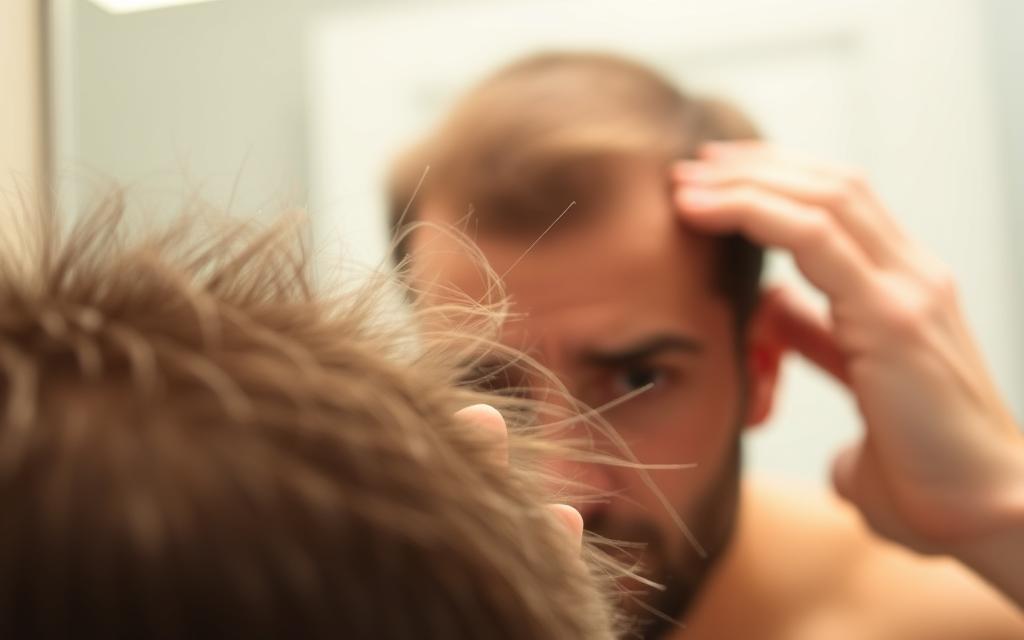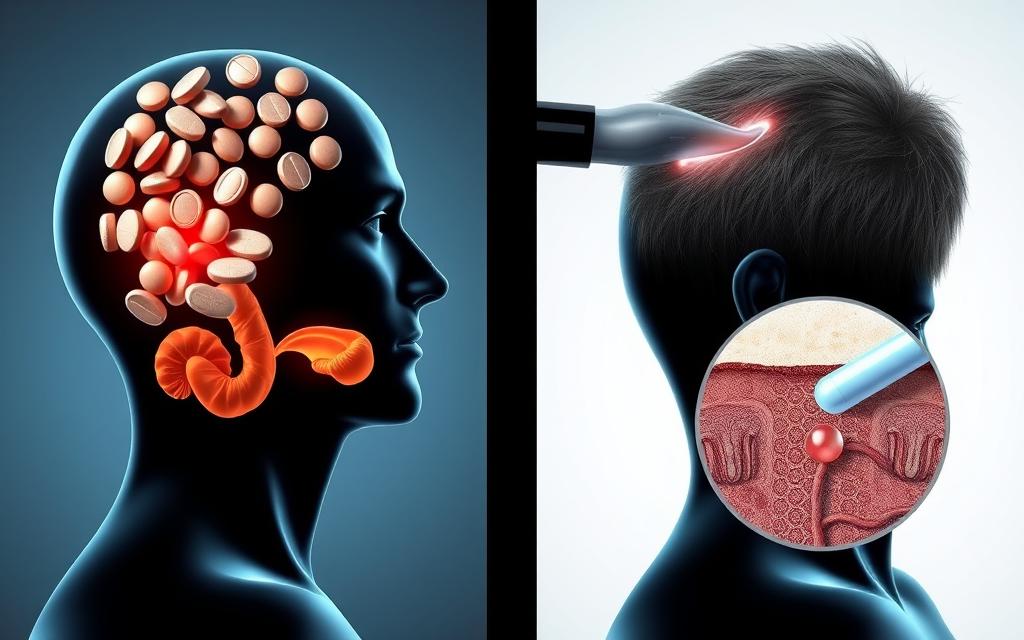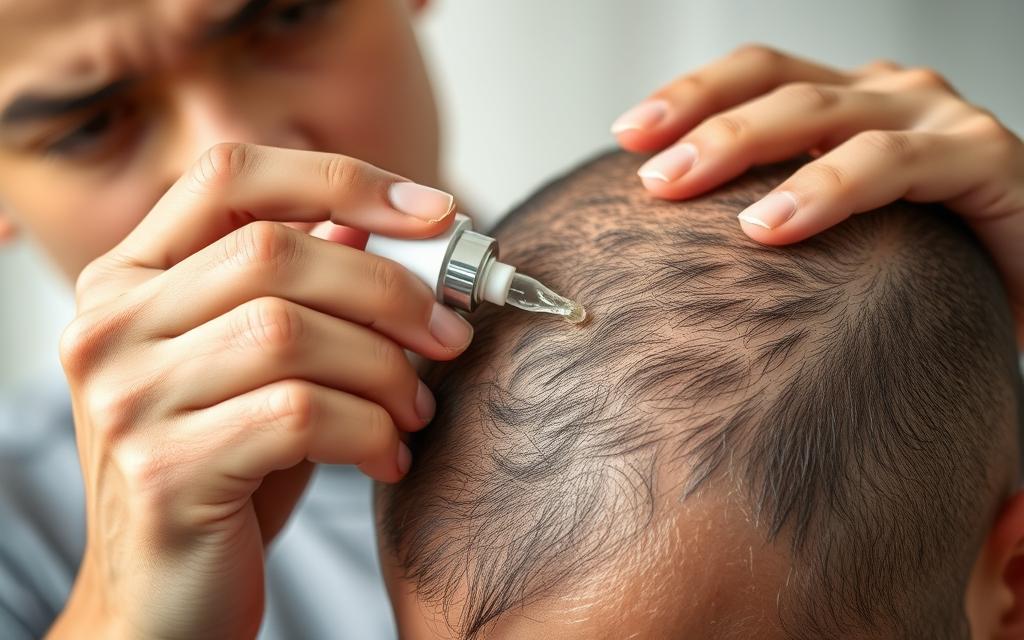Does Minoxidil Cause Erectile Dysfunction?
Hair loss is a common concern for many individuals, and minoxidil is a popular hair loss treatment. However, some users have raised concerns about its potential side effects, particularly regarding sexual health.
As people seek to address their hair loss issues, questions arise about the potential link between minoxidil and erectile dysfunction. While some users report no issues, others have expressed concerns that need to be addressed.
Understanding the relationship between hair loss treatments and sexual health is crucial. This article aims to explore whether there is a connection between using minoxidil and experiencing erectile dysfunction.
Understanding Minoxidil: An Overview
Originally developed for a different purpose, minoxidil has become a staple in the treatment of hair loss. To understand its role in addressing hair loss and potential side effects, it’s essential to delve into what minoxidil is and how it works.
What is Minoxidil and How Does it Work?
Minoxidil is a medication that was initially used to treat high blood pressure. However, during its use, an interesting side effect was observed – excessive hair growth. This led to its application in treating hair loss, particularly androgenetic alopecia. Minoxidil works by widening the hair follicle, allowing for a longer growth phase and thus promoting hair growth. It is believed to achieve this by enhancing blood flow to the scalp.
Minoxidil’s mechanism involves the vasodilation of blood vessels, which is thought to improve the supply of oxygen and nutrients to the hair follicles. This process is crucial for maintaining healthy hair growth.
Common Uses and Applications
Minoxidil is primarily used for treating hair loss, including male and female pattern baldness. It is available in various forms, including topical solutions and foams, making it easy to incorporate into daily routines.
| Application | Description |
|---|---|
| Hair Loss Treatment | Minoxidil is used to treat androgenetic alopecia in both men and women. |
| Promoting Hair Growth | By enhancing blood flow to the scalp, minoxidil promotes hair growth. |
By understanding minoxidil’s mechanism and its common applications, we can better assess its potential effects on erectile function.
The Science Behind Minoxidil
Understanding the science behind minoxidil is crucial for assessing its potential impact on erectile function. Minoxidil is a medication that has been widely used for treating hair loss and hypertension.
Mechanism of Action
Minoxidil works by widening blood vessels, which improves blood flow. When applied topically, it stimulates hair growth by prolonging the anagen phase. Its mechanism involves potassium channel opening, leading to vasodilation.
Systemic vs. Topical Effects
The effects of minoxidil can be both systemic and topical, depending on the mode of administration. Topical application is designed to minimize systemic absorption, reducing potential side effects. However, some systemic absorption still occurs.
| Effect Type | Topical Application | Systemic Administration |
|---|---|---|
| Absorption | Limited systemic absorption | Complete systemic absorption |
| Primary Use | Hair loss treatment | Hypertension management |
| Side Effects | Generally localized (e.g., scalp irritation) | Can include systemic effects like hypotension |
Understanding these differences is essential for evaluating the potential risks and benefits associated with minoxidil use, including its impact on erectile function.
Known Side Effects of Minoxidil
Understanding the potential side effects of minoxidil is essential for individuals considering this treatment for hair loss. Minoxidil, a popular medication for promoting hair growth, can cause a variety of side effects, some of which are more common than others.
Common Side Effects
The most frequently reported side effects of minoxidil are generally mild and temporary. These include itching or irritation of the scalp, dryness, and redness at the application site. Some users may also experience unwanted hair growth in other areas of the body. In most cases, these side effects resolve on their own or with minor adjustments to the treatment regimen.
| Common Side Effects | Frequency |
|---|---|
| Itching or irritation of the scalp | Common |
| Dryness or redness at the application site | Common |
| Unwanted hair growth | Less Common |

Rare Side Effects
While less frequent, some users may experience more severe side effects, including allergic reactions, dizziness, or rapid heartbeat. It’s crucial for individuals using minoxidil to be aware of these potential risks and to consult a healthcare provider if they experience any unusual symptoms.
By understanding both the common and rare side effects of minoxidil, users can make informed decisions about their treatment and monitor their health effectively.
Does Minoxidil Cause Erectile Dysfunction?
As a widely used treatment for hair loss, minoxidil’s potential side effects, including erectile dysfunction, warrant closer examination. The concern about minoxidil’s impact on erectile function is significant among its users, necessitating a thorough review of the available scientific evidence and clinical studies.
Examining the Scientific Evidence
The scientific community has investigated the potential link between minoxidil and erectile dysfunction through various studies. Some research suggests that minoxidil may not directly cause erectile dysfunction due to its localized action on the scalp when used topically. However, it’s crucial to consider the systemic absorption of minoxidil and its potential effects on vascular health.
A review of the literature reveals mixed findings. Some studies indicate that the risk of erectile dysfunction associated with minoxidil is low, while others suggest that individual susceptibility and pre-existing health conditions may play a significant role. For instance, men with cardiovascular diseases might be more prone to experiencing erectile dysfunction due to the systemic effects of minoxidil on blood pressure.
- The majority of clinical trials focus on the efficacy of minoxidil in treating hair loss.
- Few studies directly investigate the link between minoxidil and erectile dysfunction.
- Observational studies and user reports provide additional insights into potential side effects.
Clinical Studies and Research Findings
Clinical studies examining the relationship between minoxidil and erectile dysfunction have yielded varied results. A key study published in a reputable medical journal found no significant association between topical minoxidil use and erectile dysfunction in a cohort of men treated for hair loss.
However, it’s essential to consider the limitations of these studies, including sample size, duration, and the presence of confounding variables. For example, a study with a small sample size or short duration may not capture the full spectrum of potential side effects.
- The incidence of erectile dysfunction in men using minoxidil is generally low.
- Systemic absorption of minoxidil is a factor that could potentially influence erectile function.
- Individual health conditions and concurrent medication use may increase the risk of erectile dysfunction.
In conclusion, while there is some evidence suggesting that minoxidil may not be a direct cause of erectile dysfunction for most users, it’s crucial to consider individual factors and the need for continued research into the long-term effects of minoxidil use.
The Cardiovascular Connection
Minoxidil’s impact on cardiovascular health is a critical aspect of understanding its overall effect on the body. As a medication originally designed to treat high blood pressure, minoxidil’s cardiovascular effects are multifaceted.
Effects on Blood Pressure
Minoxidil is known to cause vasodilation, which can lead to a decrease in blood pressure. This effect is particularly significant for individuals with hypertension, as it can help manage their condition. However, it’s also crucial to consider the potential for hypotension in some users, particularly when combined with other medications that lower blood pressure.
The mechanism behind minoxidil’s blood pressure-lowering effect involves the opening of potassium channels in smooth muscle cells, leading to relaxation and subsequent vasodilation. This action not only affects blood pressure but also has implications for overall cardiovascular health.
Impact on Blood Flow and Erectile Function
The vasodilation caused by minoxidil can potentially improve blood flow, which is a critical factor in erectile function. Improved blood flow can enhance erectile health by ensuring that the necessary blood supply reaches the penis. However, the relationship between minoxidil, blood flow, and erectile function is complex and influenced by various factors, including overall cardiovascular health and the presence of other health conditions.
- Potential Benefits: Improved blood flow due to vasodilation.
- Potential Risks: Hypotension, particularly in combination with other blood pressure medications.
Understanding the cardiovascular effects of minoxidil is essential for assessing its overall impact on health, particularly for individuals with pre-existing cardiovascular conditions.
Psychological Factors: The Nocebo Effect
The nocebo effect, a phenomenon where negative expectations influence outcomes, may play a role in the experience of sexual side effects among minoxidil users. This concept is crucial in understanding how psychological factors can affect the perception of erectile dysfunction in individuals using minoxidil for hair loss treatment.
Understanding Nocebo in the Context of Sexual Side Effects
The nocebo effect occurs when individuals experience adverse effects due to their negative expectations about a treatment. In the context of minoxidil and erectile dysfunction, this means that if a user believes minoxidil can cause sexual side effects, they may be more likely to experience them, even if the drug itself does not directly cause such effects.
Key factors that contribute to the nocebo effect include:
- Pre-existing beliefs about the treatment’s potential side effects
- Information gathered from various sources, including online forums and healthcare providers
- Individual susceptibility to anxiety and stress related to treatment
| Factor | Description | Impact on Nocebo Effect |
|---|---|---|
| Pre-existing Beliefs | Users’ prior knowledge or beliefs about minoxidil’s side effects | High |
| Information Sources | Online forums, healthcare providers, and other sources of information | Moderate |
| Anxiety and Stress | Individual’s level of anxiety and stress regarding treatment | High |
Anxiety and Sexual Performance
Anxiety is a well-known factor that can negatively impact sexual performance. The anxiety related to potential sexual side effects of minoxidil can create a self-fulfilling prophecy, where the fear of experiencing erectile dysfunction actually contributes to its occurrence.
Reducing anxiety through education and awareness can potentially mitigate the nocebo effect and its impact on sexual function. By understanding the actual risks and benefits associated with minoxidil, users can make more informed decisions and possibly reduce their susceptibility to negative psychological influences.
Other Medications and Erectile Dysfunction
The relationship between medications and erectile dysfunction is complex, with several drugs potentially contributing to this condition. Understanding the broader context of medication-induced erectile dysfunction can help clarify the relative risks associated with minoxidil.
Common Medications Known to Cause ED
Several classes of medications have been associated with erectile dysfunction. These include:
- Antihypertensive drugs: Certain blood pressure medications, such as beta-blockers and diuretics, can affect erectile function.
- Antidepressants: Selective serotonin reuptake inhibitors (SSRIs) and other types of antidepressants can contribute to erectile dysfunction.
- Anti-androgens: Medications used to treat conditions like prostate cancer can impact erectile function due to their effect on hormone levels.
These medications can affect erectile function through various mechanisms, including altering blood flow, hormone levels, or neurotransmitter activity.
Comparing Minoxidil to Other Drugs
When comparing minoxidil to other medications known to cause erectile dysfunction, it’s essential to consider the specific mechanisms and incidence rates. Unlike some antihypertensive drugs or antidepressants, minoxidil’s primary action is vasodilation, which can potentially improve blood flow. However, its systemic absorption and effect on blood pressure may still raise concerns about its impact on erectile function.
A key difference between minoxidil and some other medications that cause erectile dysfunction is its localized application. Topical minoxidil is less likely to cause systemic side effects compared to oral medications like certain antihypertensives or antidepressants.
Managing Potential Sexual Side Effects
While minoxidil is generally well-tolerated, some users may experience sexual side effects that require attention and management. It’s essential to be aware of these potential effects and know how to address them.
Recognizing the need for professional advice is crucial. If you’re experiencing sexual side effects while using minoxidil, it’s vital to consult a healthcare provider who can offer personalized guidance.
When to Consult a Healthcare Provider
If you’re experiencing persistent or severe sexual side effects, it’s crucial to seek medical advice. A healthcare provider can help determine whether minoxidil is the cause of your symptoms and recommend alternative treatments or adjustments to your current regimen.
- Schedule an appointment if you notice any unusual symptoms.
- Be prepared to discuss your medical history and current medications.
- Ask about potential interactions with other medications you’re taking.
Monitoring and Addressing Symptoms
Keeping track of your symptoms can help you identify patterns and potential correlations with minoxidil use. Consider maintaining a symptom journal to monitor your experiences.
Early detection and intervention can significantly impact the effectiveness of managing side effects.
Alternative Hair Loss Treatments
For those concerned about the potential side effects of minoxidil, alternative hair loss treatments are available. These may include:
- Finasteride: A medication that can help slow hair loss.
- Low-Level Laser Therapy (LLLT): A non-invasive treatment that promotes hair growth.
- Platelet-rich Plasma (PRP) Therapy: A treatment that involves injecting platelet-rich plasma into the scalp.
By being proactive and informed, you can effectively manage potential sexual side effects associated with minoxidil use. Always consult with a healthcare professional before making any changes to your treatment plan.
Differentiating Between Oral and Topical Minoxidil
Oral and topical minoxidil differ significantly in terms of their absorption rates, systemic exposure, and side effect profiles. This distinction is crucial for understanding their respective impacts on hair loss treatment and potential adverse effects, including erectile dysfunction.

Absorption Rates and Systemic Exposure
The absorption rate of minoxidil varies significantly between oral and topical administrations. Topical minoxidil is applied directly to the scalp, where it is absorbed locally. Studies suggest that only a small fraction of topical minoxidil is absorbed systemically. In contrast, oral minoxidil is absorbed through the gastrointestinal tract and then distributed systemically. This difference in absorption can influence the systemic exposure and potentially impact the risk of side effects.
Oral minoxidil, being absorbed into the bloodstream, may have a broader systemic effect compared to topical application. The higher systemic concentration could theoretically increase the risk of side effects, including those related to cardiovascular health and potentially erectile function.
Reported Differences in Side Effect Profiles
The side effect profiles of oral and topical minoxidil have been observed to differ in clinical practice. Topical minoxidil is generally well-tolerated, with most side effects being localized to the scalp, such as itching or irritation. Oral minoxidil, due to its systemic absorption, may be associated with a broader range of side effects, including those related to blood pressure changes and potentially erectile dysfunction.
While both forms are used for treating hair loss, understanding these differences is essential for patients and healthcare providers to make informed decisions about treatment options and to monitor for potential side effects effectively.
Risk Factors and Individual Susceptibility
Not everyone who uses minoxidil will experience sexual side effects, but certain risk factors can increase this likelihood. Understanding these factors is crucial for individuals considering minoxidil treatment.
Pre-existing Conditions That May Increase Risk
Pre-existing health conditions can play a significant role in how an individual responds to minoxidil. Conditions such as hypertension, diabetes, and cardiovascular disease may affect the body’s response to minoxidil, potentially increasing the risk of sexual side effects. It is essential for individuals with these conditions to consult their healthcare provider before starting minoxidil treatment.
- Hypertension: High blood pressure can be both a cause and effect of erectile dysfunction.
- Diabetes: Diabetes is known to affect erectile function, and the addition of minoxidil may complicate this condition.
- Cardiovascular disease: Conditions affecting the heart and blood vessels can impact erectile function.
Genetic Factors and Individual Variations
Genetic factors can also influence how an individual metabolizes minoxidil, potentially affecting its efficacy and side effect profile. Research into genetic variations that affect drug metabolism may provide insights into why some individuals are more susceptible to minoxidil’s sexual side effects.
Some key genetic factors include variations in genes responsible for drug metabolism, such as those involved in the processing of minoxidil. Understanding these genetic factors can help in tailoring treatments to individual needs.
Conclusion
The relationship between minoxidil and erectile dysfunction (ED) has been a topic of concern for many users. After examining the available scientific evidence and research findings, it is clear that the connection between minoxidil and ED is complex.
While some studies suggest that minoxidil may contribute to ED in certain individuals, others have found no significant link. The cardiovascular effects of minoxidil, including its impact on blood pressure, may play a role in its potential to cause ED. However, the overall risk appears to be relatively low.
In conclusion, the current evidence does not conclusively establish a direct causal link between minoxidil and erectile dysfunction. Users experiencing ED while taking minoxidil should consult their healthcare provider to discuss potential risk factors and alternative treatments. By understanding the potential risks and benefits, individuals can make informed decisions about their treatment options.
